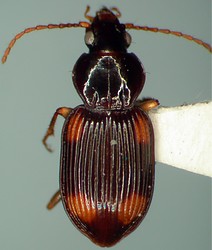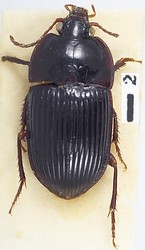Abacetini
Kipling Will


This tree diagram shows the relationships between several groups of organisms.
The root of the current tree connects the organisms featured in this tree to their containing group and the rest of the Tree of Life. The basal branching point in the tree represents the ancestor of the other groups in the tree. This ancestor diversified over time into several descendent subgroups, which are represented as internal nodes and terminal taxa to the right.

You can click on the root to travel down the Tree of Life all the way to the root of all Life, and you can click on the names of descendent subgroups to travel up the Tree of Life all the way to individual species.
For more information on ToL tree formatting, please see Interpreting the Tree or Classification. To learn more about phylogenetic trees, please visit our Phylogenetic Biology pages.
close boxIntroduction
Abacetini is a group of probably more than 500 species for which there is little modern synthesis or taxonomic revision. These beetles are distributed throughout Africa and into southern Europe, across tropical and subtropical Asia and into the Pacific as far as northern Australia.
Characteristics
A broad set of taxa have been informally associated with Abacetus based on the combination of the lack of the angular base of stria 1; a single pair of deeply impressed, linear basal impressions of the pronotum; a single or no dorsal puncture on the third elytral interval; the basal elytral puncture at or near stria two and males with symmetrically expanded protarsomeres. Additionally, nearly all of these taxa have deeply impressed, elongate frontal impressions on the head; sinuate anterior coxal sulcus and coiled spermatheca. The most obvious characteristic and likely synapomorphy for a possibly derived clade (Abacetini s.str.) is the eccentrically inserted second antennomere and, perhaps, the strongly transverse mentum. The mentum form, however, is somewhat variable. DNA sequence data also supports this clade based on a selected set of exemplars and several gene loci (K. Will unpublished).
Title Illustrations

| Scientific Name | Abacetus sp |
|---|---|
| Location | Vietnam |
| Specimen Condition | Dead Specimen |
| Identified By | K.Will |
| Life Cycle Stage | Adult |
| Body Part | Habitus |
| View | Dorsal |
| Collection | AMNH |
| Image Use |
 This media file is licensed under the Creative Commons Attribution License - Version 3.0. This media file is licensed under the Creative Commons Attribution License - Version 3.0.
|
| Copyright |
© Kipling Will

|
| Scientific Name | Celioinkosa kivuana |
|---|---|
| Life Cycle Stage | Adult |
| Image Use |
 This media file is licensed under the Creative Commons Attribution License - Version 3.0. This media file is licensed under the Creative Commons Attribution License - Version 3.0.
|
| Copyright |
© Kipling Will

|
About This Page
Kipling Will

University of California, Berkeley, California, USA
Correspondence regarding this page should be directed to Kipling Will at
Page copyright © 2006 Kipling Will
 Page: Tree of Life
Abacetini.
Authored by
Kipling Will.
The TEXT of this page is licensed under the
Creative Commons Attribution License - Version 3.0. Note that images and other media
featured on this page are each governed by their own license, and they may or may not be available
for reuse. Click on an image or a media link to access the media data window, which provides the
relevant licensing information. For the general terms and conditions of ToL material reuse and
redistribution, please see the Tree of Life Copyright
Policies.
Page: Tree of Life
Abacetini.
Authored by
Kipling Will.
The TEXT of this page is licensed under the
Creative Commons Attribution License - Version 3.0. Note that images and other media
featured on this page are each governed by their own license, and they may or may not be available
for reuse. Click on an image or a media link to access the media data window, which provides the
relevant licensing information. For the general terms and conditions of ToL material reuse and
redistribution, please see the Tree of Life Copyright
Policies.
- First online 07 July 2006
- Content changed 21 October 2006
Citing this page:
Will, Kipling. 2006. Abacetini. Version 21 October 2006 (under construction). http://tolweb.org/Abacetini/51300/2006.10.21 in The Tree of Life Web Project, http://tolweb.org/









 Go to quick links
Go to quick search
Go to navigation for this section of the ToL site
Go to detailed links for the ToL site
Go to quick links
Go to quick search
Go to navigation for this section of the ToL site
Go to detailed links for the ToL site